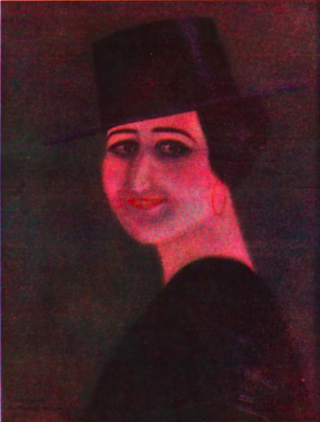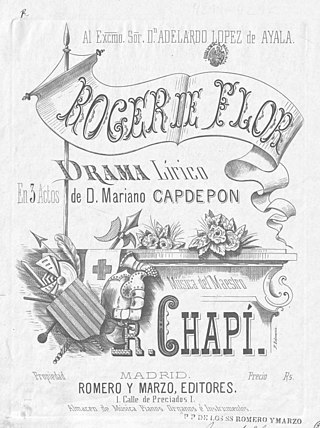Related Research Articles

Zarzuela is a Spanish lyric-dramatic genre that alternates between spoken and sung scenes, the latter incorporating operatic and popular songs, as well as dance. The etymology of the name is uncertain, but some propose it may derive from the name of a royal hunting lodge, the Palace of Zarzuela, near Madrid, where that type of entertainment was allegedly first presented to the court. The palace in turn was named after the brambles that grew there.

Comic opera, sometimes known as light opera, is a sung dramatic work of a light or comic nature, usually with a happy ending and often including spoken dialogue.
Género chico is a Spanish genre of short, light plays with music. It is a major branch of zarzuela, Spain's form of popular music theatre with dialogue, and differs from zarzuela grande and most other operatic forms both in its brevity and by being aimed at audiences of a wide social spectrum.
Opéra comique is a genre of French opera that contains spoken dialogue and arias. It emerged from the popular opéras comiques en vaudevilles of the Fair Theatres of St Germain and St Laurent, which combined existing popular tunes with spoken sections. Associated with the Paris theatre of the same name, opéra comique is not necessarily comical or shallow in nature; Carmen, perhaps the most famous opéra comique, is a tragedy.

Ruperto Chapí y Lorente was a Spanish composer, and co-founder of the Spanish Society of Authors and Publishers.

Tomás Bretón y Hernández was a Spanish conductor and composer.

Amadeu Vives i Roig was a Spanish musical composer, creator of over a hundred stage works. He is best known for Doña Francisquita, which Christopher Webber has praised for its "easy lyricism, fluent orchestration and colourful evocation of 19th Century Madrid—not to mention its memorable vocal and choral writing", and characterizes as "without doubt the best known and loved of all his works, one of the few zarzuelas which has 'travelled' abroad".

Gerónimo Giménez y Bellido was a Spanish conductor and composer, who dedicated his career to writing zarzuelas, such as La tempranica and La boda de Luis Alonso. He preferred to spell his first name with a "G", even though his name at birth officially began with a "J".
Juan Hidalgo de Polanco was a Spanish composer and harpist who became the most influential composer of his time in the Hispanic world writing the music for the first two operas created in Spanish. He is considered by many to be the father of Spanish opera and of the zarzuela.

Christopher Webber is an English musicologist, dramatist, actor, theatre director and writer.
Cuban musical theatre has its own distinctive style and history. From the 18th century to modern times, popular theatrical performances included music and often dance as well. Many composers and musicians had their careers launched in the theatres, and many compositions got their first airing on the stage. In addition to staging some European operas and operettas, Cuban composers gradually developed ideas which better suited their creole audience. Characters on stages began to include elements from Cuban life, and the music began to reflect a fusion between African and European contributions.

Manuel Penella Moreno was a Spanish composer. His father was the composer Manuel Penella Raga. His daughter Magdalena Penella Silva married the politician Ramón Ruiz Alonso; through her, he was the grandfather of actresses Emma Penella, Elisa Montés and Terele Pávez.

The Teatro de la Zarzuela is a theatre in Madrid, Spain. The theatre is today mainly devoted to zarzuela, as well as operetta and recitals.

Tonadilla was a Spanish musical song form of theatrical origin; not danced. The genre was a type of short, satirical musical comedy popular in 18th-century Spain, and later in Cuba and other Spanish colonial countries.
Andrew Martin Lamb is an English writer, music historian, lecturer and broadcaster, known for his expertise in light music and musical theatre. In addition to his musical work, Lamb maintained a full-time career as an actuary and investment manager.
Joaquín Valverde Durán was a Spanish composer, conductor and flautist. As a composer he is known for his collaborations on zarzuelas. He was also the father of Joaquín "Quinito" Valverde Sanjuán, who achieved a greater level of fame.

Eugenio Sellés y Ángel, Marquess of Gerona and Viscount of Castro and Orozco was a Spanish writer, journalist, playwright and politician.

Roger de Flor is an opera in three acts by Ruperto Chapí for libretto by Mariano Capdepón. It is the third of the three operas composed by Chapí during his studies in Paris and Italy. It was staged for the first time at the Teatro Real in Madrid on 23 January 1878. The first modern performance was on 10 March 2012 in Palau de la Música de València in a concert performance.
References
- 1 2 3 Temperley: "Opera", Grove Music Online
- 1 2 3 4 Christopher Webber: The Zarzuela Companion (Scarecrow Press Inc., 2002) Lib. Cong. 2002110168 / ISBN 0-8108-4447-8
